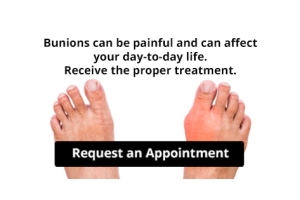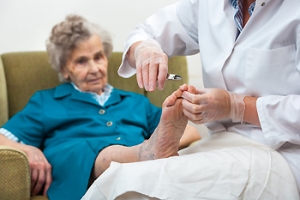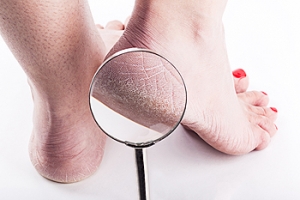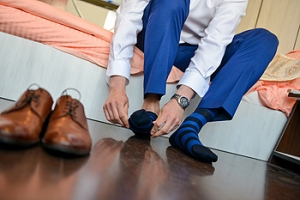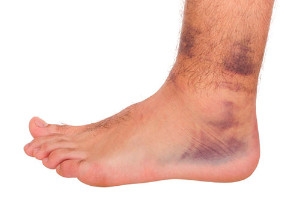Items filtered by date: May 2019
Are Bunions Affecting Your Everyday Life?
Have you noticed a bony protrusion on the side of your big toe? If so, you may have developed the foot condition known as a bunion. Don't let bunions interfere with your daily activities.
The Importance of Caring for Diabetic Feet
Elevated blood sugar levels are the main cause of diabetes. People who have this condition have to pay extra attention in caring for their feet. Diabetic patients may experience a tingling feeling or numbing sensation, and this can make it difficult in noticing any cuts that may be present on the feet. This type of nerve damage can lead to an infection and can cause gangrene if it is not treated promptly. Typical symptoms of a foot infection can include fever, unmanageable blood sugar levels, and skin discoloration. If you are a diabetic patient and would like information about taking care of your feet, it is advised to seek the counsel of a podiatrist who can properly guide you.
Diabetic foot care is important in preventing foot ailments such as ulcers. If you are suffering from diabetes or have any other concerns about your feet, contact Dr. Kenneth Donovan from Advanced Care Foot and Ankle. Our doctor can provide the care you need to keep you pain-free and on your feet.
Diabetic Foot Care
Diabetes affects millions of people every year. The condition can damage blood vessels in many parts of the body, especially the feet. Because of this, taking care of your feet is essential if you have diabetes, and having a podiatrist help monitor your foot health is highly recommended.
The Importance of Caring for Your Feet
- Routinely inspect your feet for bruises or sores.
- Wear socks that fit your feet comfortably.
- Wear comfortable shoes that provide adequate support.
Patients with diabetes should have their doctor monitor their blood levels, as blood sugar levels play such a huge role in diabetic care. Monitoring these levels on a regular basis is highly advised.
It is always best to inform your healthcare professional of any concerns you may have regarding your feet, especially for diabetic patients. Early treatment and routine foot examinations are keys to maintaining proper health, especially because severe complications can arise if proper treatment is not applied.
If you have any questions please feel free to contact one of our offices located in Warren, Livingston, and Toms River, NJ . We offer the newest diagnostic and treatment technologies for all your foot and ankle needs.
Possible Causes of Cracked Heels
When the skin on the heels become dry, a condition that is referred to as cracked heels may develop. This can happen from a variety of reasons. These include standing for extended periods of time throughout the day, wearing shoes that have an open back, or being obese. Additionally, existing medical conditions such as diabetes, eczema, or thyroid disorders can contribute to the formation of cracked heels. Mild relief may be found when the feet are soaked in warm water, followed by applying a moisturizer to the affected areas. There are patients who find it helpful to use oil on the heels, and then wearing socks to bed. If you have cracked heels and would like additional information on effective remedies, it is advised to seek the counsel of a podiatrist.
Cracked heels are unsightly and can cause further damage to your shoes and feet. If you have any concerns, contact Dr. Kenneth Donovan from Advanced Care Foot and Ankle. Our doctor can provide the care you need to keep you pain-free and on your feet.
Cracked Heels
Cracked heels appear unappealing and can make it harder for you walk around in sandals. Aside from looking unpleasant, cracked heels can also tear stockings, socks, and wear out your shoes. There are several methods to help restore a cracked heel and prevent further damage.
How Do You Get Them?
Dry skin is the number one culprit in creating cracked heels. Many athletes, walkers, joggers, and even swimmers suffer from cracked heels. Age and skin oil production play a role to getting cracked heels as well.
Promote Healing
Over the counter medicines can help, especially for those that need instant relief or who suffer from chronic dry feet.
Wear Socks – Wearing socks with medicated creams helps lock in moisture.
Moisturizers – Applying both day and night will help alleviate dryness which causes cracking.
Pumice Stones – These exfoliate and remove dead skin, which allows for smoother moisturizer application and better absorption into the skin.
Change in Diet
Eating healthy with a well-balanced diet will give the skin a fresh and radiant look. Your body responds to the kinds of food you ingest. Omega-3 fatty acids and zinc supplements can also revitalize skin tissue.
Most importantly, seek professional help if unsure how to proceed in treating cracked heels. A podiatrist will help you with any questions or information needed.
If you have any questions, please feel free to contact one of our offices located in Warren, Livingston, and Toms River, NJ . We offer the newest diagnostic and treatment technologies for all your foot care needs.
Possible Causes of Cracked Heels
 When the skin on the heels become dry, a condition that is referred to as cracked heels may develop. This can happen from a variety of reasons. These include standing for extended periods of time throughout the day, wearing shoes that have an open back, or being obese. Additionally, existing medical conditions such as diabetes, eczema, or thyroid disorders can contribute to the formation of cracked heels. Mild relief may be found when the feet are soaked in warm water, followed by applying a moisturizer to the affected areas. There are patients who find it helpful to use oil on the heels, and then wearing socks to bed. If you have cracked heels and would like additional information on effective remedies, it is advised to seek the counsel of a podiatrist.
When the skin on the heels become dry, a condition that is referred to as cracked heels may develop. This can happen from a variety of reasons. These include standing for extended periods of time throughout the day, wearing shoes that have an open back, or being obese. Additionally, existing medical conditions such as diabetes, eczema, or thyroid disorders can contribute to the formation of cracked heels. Mild relief may be found when the feet are soaked in warm water, followed by applying a moisturizer to the affected areas. There are patients who find it helpful to use oil on the heels, and then wearing socks to bed. If you have cracked heels and would like additional information on effective remedies, it is advised to seek the counsel of a podiatrist.
Cracked heels are unsightly and can cause further damage to your shoes and feet. If you have any concerns, contact Dr. Kenneth Donovan from Advanced Care Foot and Ankle. Our doctor can provide the care you need to keep you pain-free and on your feet.
Cracked Heels
Cracked heels appear unappealing and can make it harder for you walk around in sandals. Aside from looking unpleasant, cracked heels can also tear stockings, socks, and wear out your shoes. There are several methods to help restore a cracked heel and prevent further damage.
How Do You Get Them?
Dry skin is the number one culprit in creating cracked heels. Many athletes, walkers, joggers, and even swimmers suffer from cracked heels. Age and skin oil production play a role to getting cracked heels as well.
Promote Healing
Over the counter medicines can help, especially for those that need instant relief or who suffer from chronic dry feet.
Wear Socks – Wearing socks with medicated creams helps lock in moisture.
Moisturizers – Applying both day and night will help alleviate dryness which causes cracking.
Pumice Stones – These exfoliate and remove dead skin, which allows for smoother moisturizer application and better absorption into the skin.
Change in Diet
Eating healthy with a well-balanced diet will give the skin a fresh and radiant look. Your body responds to the kinds of food you ingest. Omega-3 fatty acids and zinc supplements can also revitalize skin tissue.
Most importantly, seek professional help if unsure how to proceed in treating cracked heels. A podiatrist will help you with any questions or information needed.
If you have any questions, please feel free to contact one of our offices located in Warren, Livingston, and Toms River, NJ . We offer the newest diagnostic and treatment technologies for all your foot care needs.
Keeping Your Feet Healthy While Working on Your Feet
There are many professions that require standing for hours, which unfortunately can put a heavy strain on the feet. Oftentimes, people who work on their feet begin to notice aches and pains associated with the stress their feet are under. Examples of common problems that arise from working on your feet are plantar fasciitis, bunions, Achilles tendonitis, swollen feet, and soreness. There are a few simple ways to reduce the risk of developing any of these issues. Wearing comfortable and supportive shoes is the most important step in keeping your feet healthy. Custom made orthotics could also be beneficial. Orthotics made for those who stand for long periods of time could help improve posture, relieve joint pain, and help alleviate other symptoms. Changing positions is also beneficial, because it helps shift the weight being put on the feet. If possible, walking around, standing in different positions, and stretching are easy ways to change position. If you would like more information on how to care for your feet, speak with your podiatrist.
While working on the feet, it is important to take the proper care of them. For more information about working on your feet, contact Dr. Kenneth Donovan from Advanced Care Foot and Ankle. Our doctor will treat your foot and ankle needs.
Working on Your Feet
Standing on your feet for long periods of time can cause stress and pain in your feet. Your whole body may experience change in terms of posture, back pain, bunions, callouses and or plantar warts. There are ways to avoid these conditions with proper foot care, smart choices and correct posture.
Positive Changes
Negative heeled shoe – Choosing this shoe type places the heel slightly lower than the ball of the foot. These are great for overall foot health. Find shoes that fit you correctly.
Go barefoot – Our feet were not designed to be enclosed for all hours of the day. Try to periodically expose your feet to air.
Eliminate Pain
Foot Exercises – Performing simple exercises, incorporating yoga and doing stretches are beneficial. This will allow increased blood flow to the area and muscles of the foot.
Achilles tendon – Stretching the foot out flat on the floor will relax the calf muscles and tendon. These exercises can be performed almost anywhere. Make sure you add these exercises to your daily regimen.
With a little bit of this information and knowing more about foot health, you will notice changes. Foot stretches and proper footwear will help with pain and prevent further issues.
If you have any questions please feel free to contact one of our offices located in Warren, Livingston, and Toms River, NJ. We offer the newest diagnostic and treatment technologies for all your foot and ankle needs.
Are You Suffering From Ingrown Toenails?
Two Types of Ankle Sprains
If ligaments in the ankle are torn or stretched, it is indicative of an ankle sprain. The purpose of these ligaments is to hold the ankle in place. If you have sprained your ankle, pain and discomfort is often experienced, and it may be difficult to bear any weight on the foot. Research has indicated there are two types of ankle sprains. These include eversion and inversion sprains. If the ankle turns in an outward direction, this is typically an eversion sprain. The latter occurs when the foot is twisted, and the ankle rolls inward. Some of the reasons why this type of injury occurs include wearing the wrong shoes, which can make it easier to fall, in addition to participating in high impact sporting activities. This produces stress on the ankle joints, which can lead to weakness in the foot. If you feel you have sprained your ankle, it is suggested to speak to a podiatrist who can perform a complete evaluation of the injured foot.
Although ankle sprains are common, they aren’t always minor injuries. If you need your ankle injury looked at, contact Dr. Kenneth Donovan from Advanced Care Foot and Ankle. Our doctor can provide the care you need to keep you pain-free and on your feet.
How Does an Ankle Sprain Occur?
Ankle sprains are the result of a tear in the ligaments within the ankle. These injuries may happen when you make a rapid shifting movement while your foot is planted. A less common way to sprain your ankle is when your ankle rolls inward while your foot turns outward.
What Are the Symptoms?
- Pain at the sight of the tear
- Bruising/Swelling
- Ankle area is tender to touch
- In severe cases, may hear/feel something tear
- Skin discoloration
Preventing a Sprain
- Wearing appropriate shoes for the occasion
- Stretching before exercises and sports
- Knowing your limits
Treatment of a Sprain
In many cases, the RICE method (Rest, Ice, Compression, and Elevate) is used to treat ankle sprains. However, you should see a podiatrist to see which treatment option would work best with your injury. In severe cases, surgery may be required.
It is important to ask your doctor about rehab options after you receive treatment for your injury. Stretching, strength training, and balance exercises may help the ankle heal while also preventing further injury.
If you have any questions, please feel free to contact one of our offices located in Warren, Livingston, and Toms River, NJ. We offer the newest diagnostic and treatment technologies for all your foot care needs.
Two Types of Ankle Sprains
 If ligaments in the ankle are torn or stretched, it is indicative of an ankle sprain. The purpose of these ligaments is to hold the ankle in place. If you have sprained your ankle, pain and discomfort is often experienced, and it may be difficult to bear any weight on the foot. Research has indicated there are two types of ankle sprains. These include eversion and inversion sprains. If the ankle turns in an outward direction, this is typically an eversion sprain. The latter occurs when the foot is twisted, and the ankle rolls inward. Some of the reasons why this type of injury occurs include wearing the wrong shoes, which can make it easier to fall, in addition to participating in high impact sporting activities. This produces stress on the ankle joints, which can lead to weakness in the foot. If you feel you have sprained your ankle, it is suggested to speak to a podiatrist who can perform a complete evaluation of the injured foot.
If ligaments in the ankle are torn or stretched, it is indicative of an ankle sprain. The purpose of these ligaments is to hold the ankle in place. If you have sprained your ankle, pain and discomfort is often experienced, and it may be difficult to bear any weight on the foot. Research has indicated there are two types of ankle sprains. These include eversion and inversion sprains. If the ankle turns in an outward direction, this is typically an eversion sprain. The latter occurs when the foot is twisted, and the ankle rolls inward. Some of the reasons why this type of injury occurs include wearing the wrong shoes, which can make it easier to fall, in addition to participating in high impact sporting activities. This produces stress on the ankle joints, which can lead to weakness in the foot. If you feel you have sprained your ankle, it is suggested to speak to a podiatrist who can perform a complete evaluation of the injured foot.
Although ankle sprains are common, they aren’t always minor injuries. If you need your ankle injury looked at, contact Dr. Kenneth Donovan from Advanced Care Foot and Ankle. Our doctor can provide the care you need to keep you pain-free and on your feet.
How Does an Ankle Sprain Occur?
Ankle sprains are the result of a tear in the ligaments within the ankle. These injuries may happen when you make a rapid shifting movement while your foot is planted. A less common way to sprain your ankle is when your ankle rolls inward while your foot turns outward.
What Are the Symptoms?
- Pain at the sight of the tear
- Bruising/Swelling
- Ankle area is tender to touch
- In severe cases, may hear/feel something tear
- Skin discoloration
Preventing a Sprain
- Wearing appropriate shoes for the occasion
- Stretching before exercises and sports
- Knowing your limits
Treatment of a Sprain
In many cases, the RICE method (Rest, Ice, Compression, and Elevate) is used to treat ankle sprains. However, you should see a podiatrist to see which treatment option would work best with your injury. In severe cases, surgery may be required.
It is important to ask your doctor about rehab options after you receive treatment for your injury. Stretching, strength training, and balance exercises may help the ankle heal while also preventing further injury.
If you have any questions, please feel free to contact one of our offices located in Warren, Livingston, and Toms River, NJ . We offer the newest diagnostic and treatment technologies for all your foot care needs.

